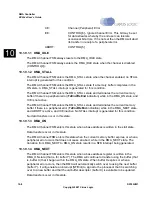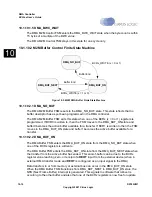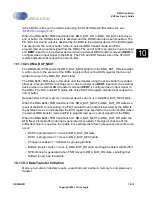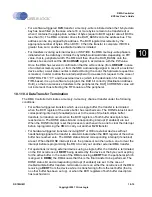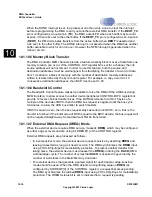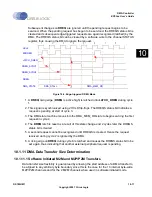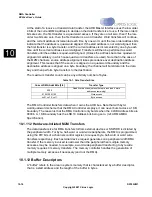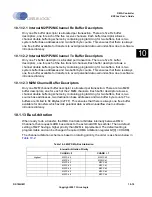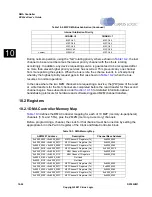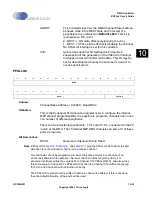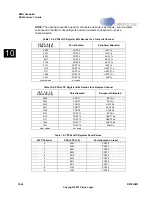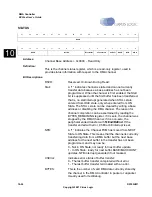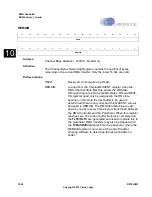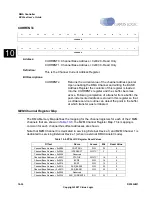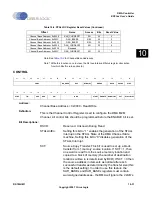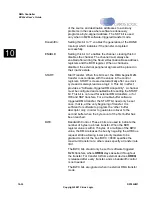
10-18
DS785UM1
Copyright 2007 Cirrus Logic
DMA Controller
EP93xx User’s Guide
1
0
1
0
10
At the start of a receive or transmit data transfer, the AHB Master Interface uses the low order
4 bits of the current DMA address to decide on the data transfer size to use. If the low-order 4
bits are zero, the first transfer is a quad word access. If they are not all zero, then if the low-
order two bits are zero, then the first transfer is a word transfer. Word transfers will continue,
and the current address incremented each time by one word, until the low-order address bits
indicate that the address is quad-word aligned. If the start address is not word aligned, then
the first transfer is a byte transfer, and the current address is incremented by one byte each
time until the current address is word aligned. Transfers will then be performed as word
transfers until the address is quad-word aligned. (Unless the address becomes quad-word
aligned immediately, in which case quad word transfers are used). Note that in the case of
the M2M channels, source address alignment takes precedence over destination address
alignment. This means that if the source is aligned on a quad-word boundary and the
destination address is aligned on a byte boundary, the channel will burst data into the data
bay and then perform byte transfers to the destination.
The maximum transfer count can be any arbitrary number of bytes.
The DMA Controller transfers data when it owns the AHB bus. Note that with byte/
word/quad-word scheme that the DMA Controller employs, it can never burst across a 1KB
boundary. The reason is that the DMA Controller only bursts when the 4 LSB Address bits are
0000b. A 1 KB boundary has the LSB 10 Address bits being zero. (ref: ARM AMBA
Specification).
10.1.11.2 Hardware-Initiated M2M Transfers
The data transfer size for DMA transfers to/from external devices or SSP/IDE is dictated by
the peripheral width. For byte, half-word or word wide peripherals, the DMA is programmed,
using the PW bits of a channels control register, to request byte, half-word or word wide
transfers respectively. Each external device request generates one peripheral width DMA
transfer. If the memory involved is narrower than the peripheral then multiple memory
accesses may be needed, for example, a word wide peripheral transferring to byte wide
memory requires 4 memory transfers. The memory controller handles the generation of
multiple memory accesses if necessary (and not the DMA).
10.1.12 Buffer Descriptors
A “buffer” refers to the area in system memory that is characterized by a buffer descriptor,
that is, a start address and the length of the buffer in bytes.
Table 10-1. Data Transfer Size
Current DMA Addr Bits [3:0]
Transfer Type
0000
Quad-Word access (unless there are less than 4 word
addresses remaining)
0100,1000,1100
Word access
xx01, xx10, xx11
Byte access
Summary of Contents for EP93 Series
Page 28: ...P 6 DS785UM1 Copyright 2007 Cirrus Logic Preface EP93xx User s Guide PP P ...
Page 162: ...5 36 DS785UM1 Copyright 2007 Cirrus Logic System Controller EP93xx User s Guide 55 5 ...
Page 576: ...15 18 DS785UM1 Copyright 2007 Cirrus Logic UART2 EP93xx User s Guide 1515 15 ...
Page 634: ...17 38 DS785UM1 Copyright 2007 Cirrus Logic IrDA EP93xx User s Guide 1717 17 ...
Page 648: ...19 6 DS785UM1 Copyright 2007 Cirrus Logic Watchdog Timer EP93xx User s Guide 1919 19 ...
Page 688: ...21 32 DS785UM1 Copyright 2007 Cirrus Logic I2S Controller EP93xx User s Guide 2121 21 ...
Page 790: ...27 20 DS785UM1 Copyright 2007 Cirrus Logic IDE Interface EP93xx User s Guide 2727 27 ...
Page 808: ...28 18 DS785UM1 Copyright 2007 Cirrus Logic GPIO Interface EP93xx User s Guide 2828 28 ...





